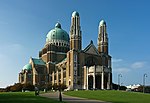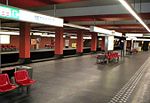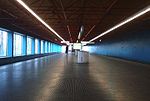Molenbeek-Saint-Jean Cemetery

Molenbeek-Saint-Jean Cemetery (French: Cimetière de Molenbeek-Saint-Jean, Dutch: Begraafplaats van Sint-Jans-Molenbeek) is a cemetery belonging to the municipality of Molenbeek-Saint-Jean, Brussels, Belgium, where the municipality's inhabitants have the right to be buried. It is located at 539, Chaussée de Gand/Gentsesteenweg, in the west of the municipality. The ensemble extends over 1.5 hectares (3.7 acres). The cemetery was inaugurated on 16 August 1864 to replace the old parish cemetery around the Church of St. John the Baptist, which had become too small, and whose last remains were cleared in 1932. Today, it concentrates a considerable protected heritage, including funeral galleries and a columbarium initially imagined for Laeken Cemetery and built in 1880, as well as several chapels.
Excerpt from the Wikipedia article Molenbeek-Saint-Jean Cemetery (License: CC BY-SA 3.0, Authors, Images).Molenbeek-Saint-Jean Cemetery
Avenue du Château - Kasteellaan,
Geographical coordinates (GPS) Address Nearby Places Show on map
Geographical coordinates (GPS)
| Latitude | Longitude |
|---|---|
| N 50.861111111111 ° | E 4.3108333333333 ° |
Address
Stade Henry Pevenage - Henry Pevenage stadion
Avenue du Château - Kasteellaan 1
1080
Belgium
Open on Google Maps










